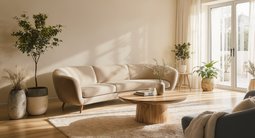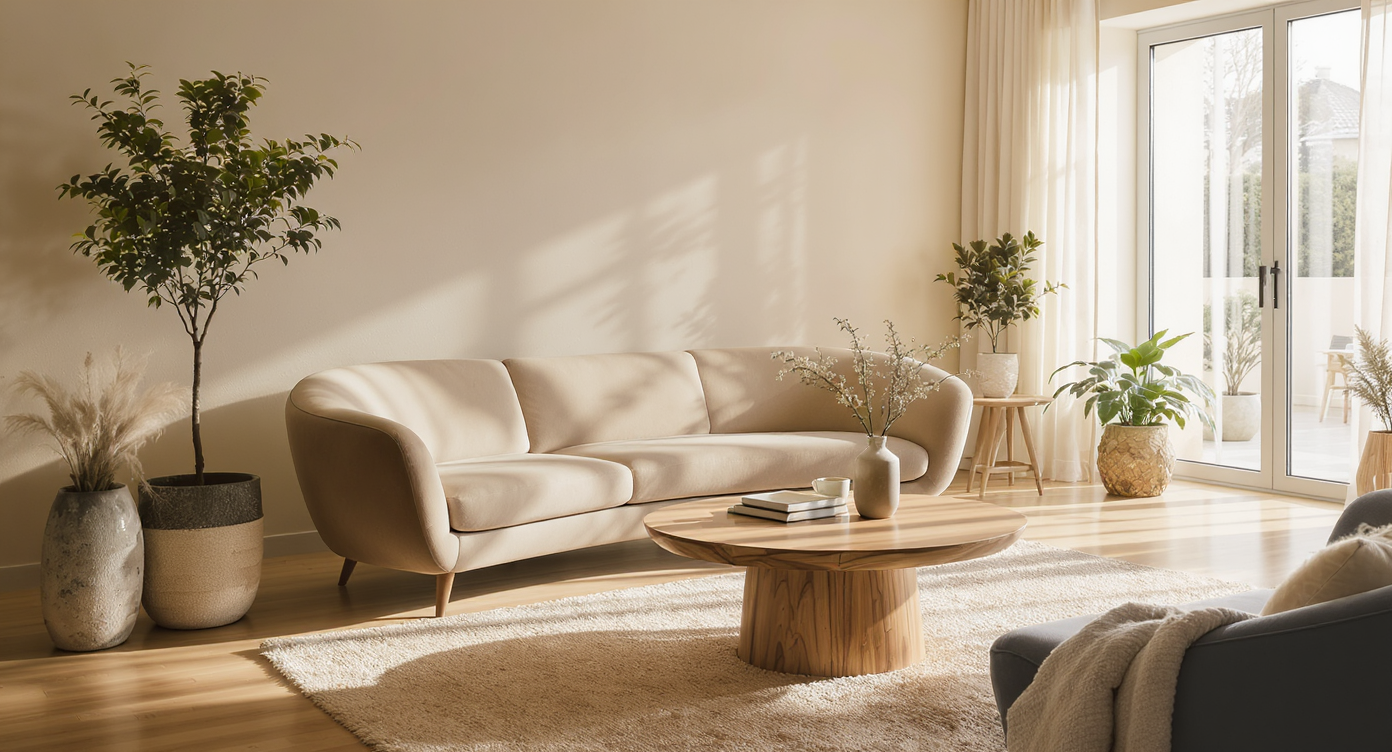TL;DR
Design in 2025 is comfort-forward and planet-minded, with curved furniture, natural materials, and modular pieces leading the way. Expect warm neutrals punctuated by colour, plus handcrafted, durable buys that outlast fast décor. For searchers asking how to choose sustainable furniture that lasts, the rule is simple: buy less, buy better, and maintain well.
Why 2025’s Furniture Trend feels different

Curved furniture and natural materials maximize comfort and space in compact, calm living environments.
Here’s the thing: people are spending most of their lives at home, and furniture is carrying the weight of that reality. In 2025, the furniture trend is less about statement for statement’s sake and more about how a sofa, table, or chair can steady the rhythm of daily life. The best pieces blend tactility, durability, and a human scale that invites you to sit, read, nap, host, and repeat.
Search interest in curved furniture, sustainable furniture, and multifunctional seating continues to climb because homeowners want spaces that feel soothing and perform under pressure. Designers often note that when materials are honest — solid wood, wool, linen, stone — rooms read calmer and age better. The tone is warm modern: fewer hard edges, more organic shapes; less disposable décor, more investment pieces.
I’ve seen this play out in real homes. A couple in a 700-square-foot apartment swapped a boxy loveseat for a petite curved two-seater and freed up just enough circulation to make their living room work again. Sometimes a gentle arc solves a sharp problem.
The big picture: what unites 2025 furniture trends
This year’s interiors are slowing down — trading glossy minimalism for tactile comfort and responsible materials. Expect a palette of warm neutrals, sculptural silhouettes, and handcrafted details that show the maker’s hand.
Across projects, three threads keep showing up: sustainability, soft geometry, and small-space functionality. Keywords like curved furniture, natural wood furniture, and modular sectional are more than trends — they’re the toolkit for creating rooms that feel grounded and adaptable. Experts recommend allowing 30 to 36 inches for main walkways so these choices still breathe.
Anecdote
A renter in a studio swapped a square coffee table for a round pedestal and instantly gained smoother circulation; guests stopped clipping the corners, and the room finally felt calm enough to read in.
The design trends to know now
Soft Geometry: Curved Furniture
Curved seating and rounded tables soften traffic flow and make compact rooms feel more welcoming. As a rule of thumb, leave 16 to 18 inches between a sofa and coffee table for comfortable reach.
Curved furniture signals a shift toward comfort-led modernism: crescent sofas, pillowy club chairs, and bullnose-edged tables that echo organic shapes found in nature. The visual payoff is immediate — fewer harsh corners, more conversation-friendly layouts. Designers often advise choosing a curved piece as the focal point, then echoing the arc in a lamp or rug motif for cohesion. In small living rooms, curved silhouettes reduce the “boxy” feel and improve movement lines. For proportion, aim for coffee tables roughly two-thirds the length of your sofa and within two inches of seat height for ergonomic ease.
How to Bring It Home
- Start with one hero: a curved sofa or round coffee table.
- Balance soft lines with one tailored piece, like a rectilinear console.
- Rug tip: an oval or round rug can visually widen tight rooms.
Nature First: Natural Wood Furniture and Textiles
Natural materials age gracefully and help regulate indoor comfort; solid wood, wool, linen, and stone add breathable texture with low visual noise.
From white oak dining tables to wool bouclé chairs, the materials story is big in 2025. Natural wood furniture showcases grain and joinery, while wool, cotton, and Belgian linen offer durability with a tactile hand. Stone side tables and clay finishes layer in quiet, earthy depth. Experts recommend allocating at least 24 inches of table width per diner for elbow room when selecting a dining table. Many designers also note rising demand for FSC-certified wood and low-VOC finishes for healthier indoor air. The visual language is honest and enduring, which is why it pairs so well with both modern and vintage pieces.
How to Bring It Home
- Mix tone-on-tone woods; vary the grain rather than matching stains.
- Choose slipcovered, washable natural fabrics for kid- and pet-friendly living.
- Ground light woods with textural rugs: jute-wool blends add warmth without weight.
Buy Once: Sustainable, Heirloom-Quality Furniture
Longevity is the most sustainable choice; invest in high-use pieces and maintain them well. A common budgeting rule is to spend 60–70% on sofas, mattresses, and dining tables that work hardest.
Sustainable furniture in 2025 means responsibly sourced materials, repairable construction, and timeless silhouettes. Look for kiln-dried hardwood frames, eight-way hand-tied or sinuous spring support, replaceable cushion cores, and hardware you can service. Designers often advise choosing certified woods and durable finishes, then using trend accents on items easy to swap, like stools or side tables. Proper care stretches life: rotate cushions monthly, vacuum upholstery weekly, and re-oil solid wood twice a year. The goal is simple — fewer, better pieces that age with you.
How to Bring It Home
- Check joinery: mortise-and-tenon or dovetail beats staples.
- Prioritize reversible cushions and zip-off covers for easy refreshes.
- Favor warranties and brands that offer parts and repairs.
Small-Space Heroes: Multifunctional & Modular Furniture
Modular furniture adapts as life changes; aim for at least 30 inches of clear path through the room to keep reconfigurations comfortable.
City footprints are shrinking, so furniture has to do more. Modular sectionals shift from movie night to guest sleep setup. Storage coffee tables hide throws and remotes, and nesting side tables expand on demand. Wall-mounted desks and drop-leaf consoles carve out work zones without hogging floor space. Experts recommend choosing pieces on visible legs to lighten small rooms and using taller storage to draw the eye up. Bonus rule: in tight layouts, keep primary seating under 90 inches and choose arm profiles that don’t steal usable width.
How to Bring It Home
- Pick one convertible anchor: sleeper sofa, storage platform bed, or gateleg table.
- Use the 3-2-1 layout: three seats on the main sofa, two occasional chairs, one compact ottoman.
- Opt for plug-in sconces over floor lamps to reclaim floor area.
How these trends overlap—and where they diverge
Though each trend is distinct, they share a return to texture, craft, and restraint. Curved furniture, natural materials, and modular designs all prioritize feel and function, not just looks.
Color sits comfortably in this mix: warm neutrals set the base — camel, mushroom, tobacco — while saturated hits like moss, oxblood, or ultramarine add personality through a chair, rug, or art. The contrast to watch is polish versus patina. A stone-topped pedestal table next to a linen slipcovered chair delivers both structure and softness, which is why designers often advise pairing one sculptural piece with one cozy textile in every vignette.
Pinpointing the pitfalls
What People Often Get Wrong About 2025 Design Trends
- Mistaking “organic” for clutter: Keep negative space. Every curved moment needs breathing room.
- Over-matching wood tones: Vary grain and sheen instead of chasing a perfect color match.
- Buying trendy big, skimping on basics: Invest in the sofa and table; save the trend splash for accents.
- Ignoring scale in small rooms: Keep seat depths under 38 inches if you need tighter circulation.
Expert Insights & Mini-Anecdotes
A homeowner traded a low, boxy ottoman for a round one with hidden storage; traffic smoothed out overnight and the living room gained a quick-clean spot for games and throws. Small curves can make oversized impact.
Another family upgraded to a modular sectional with removable covers; when their toddler’s juice met the chaise, the fabric went straight into the wash instead of into the landfill. Designers often advise, “Choose the life you live, then the fabric you need.”
Pro rule: coffee tables should be about two-thirds the sofa length and sit 1–2 inches below seat height for ideal reach and sightlines.
Tools, Resources & Visualization
Test-drive these ideas before you buy. With ReimagineHome, you can visualize curved furniture in your actual layout, preview warm neutral paint on your walls, or swap a standard sofa for a modular sectional in seconds.
- Suggested image alt text: “curved sofa in warm neutral living room 2025 furniture trend.”
- Suggested caption: “Natural wood furniture and wool upholstery create calm, durable style.”
- Suggested image alt text: “multifunctional modular sectional for small living room layout.”
Visualization Scenario
Picture a living room bathed in mushroom taupe, an oak pedestal table beside a linen swivel, and a curved sofa that hugs a round wool rug — quiet, tactile, and ready for real life. Use ReimagineHome to toggle fabrics, woods, and layout in minutes.
FAQs
- How should I place a curved sectional in a small living room?
Designers advise floating a curved sectional 6–12 inches off the wall and keeping 30–36 inches of clearance for main pathways to maintain flow. - What’s the best way to choose sustainable furniture that lasts?
Look for certified wood, repairable construction, replaceable cushion cores, and warranties; invest most in high-use pieces like sofas and tables. - How do I mix natural wood furniture with modern décor?
Pair light woods with textured rugs and matte metals; vary grain and sheen, and keep stains within two tones for harmony. - What furniture layout works best for small spaces?
Use multifunctional furniture, visible legs, and nesting tables; keep primary seating under 90 inches and maintain at least 30 inches of clear path.
Where furniture design is heading next
In 2025, design isn’t chasing novelty; it’s curating ease. Curved lines encourage closeness, natural materials slow the eye, and sustainable construction keeps pieces in play for years. The modern home asks furniture to be beautiful, useful, and gentle on the planet — and these trends answer.
Start with one change that affects how you live every day: a better sofa, a smarter table, a chair that finally supports your back. Then layer in texture, warmth, and light. And if you want to see the transformation before committing, map it out with ReimagineHome and design toward a home that feels as good as it looks.




.svg)

.svg)



.png)